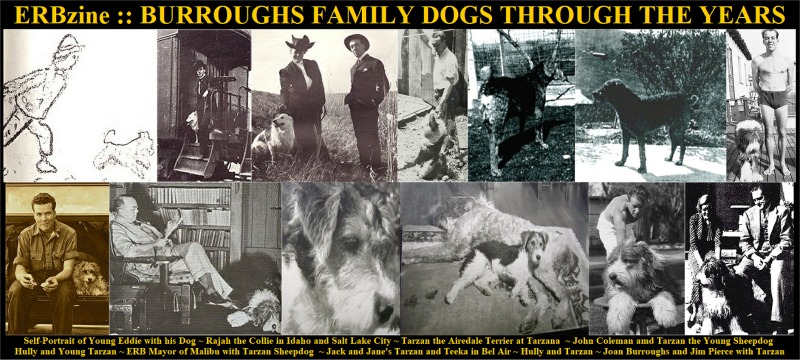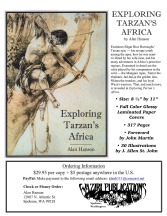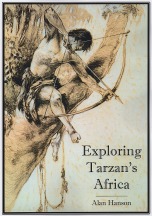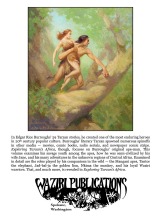
Dogs in the Life and Fiction
of
Edgar Rice Burroughs
by Alan Hanson
Part One:
A Short History of Dogs in ERB’s Life
Do you remember Rahna, Tige, Terkoz,
Za, and Raja? What about Ranee, Nobs, Lonay, and Woola? They were all canine
characters that played significant roles in Burroughs’ stories. They interacted
with human characters in the American heartland and sub-Saharan Africa,
on the island of Caspak in the South Pacific, in Pellucidar at the Earth’s
core, and across the void on Mars. In addition, references to dogs and
their unique characteristics can be found intermingled throughout ERB’s
fiction from beginning to end. (My typed notes on dog references in his
fiction run 43 pages!) It’s not surprising that Burroughs included so many
dog characters and images in his fiction. His biographer, Irwin Porges,
says ERB “developed a lasting fondness for dogs” in his childhood, and
they were always a part of his adult life up until his last years.
We don’t know the number, kinds, or names of the dogs
that were part of the Burroughs family when ERB was growing up. In Porges’
biography, the first mention of ERB’s encounter with a dog was far from
a friendly one. It happened in the summer of 1895, when the 20-year-old
Burroughs was working for the Knickerbocker Ice Company in Chicago. ERB’s
area was in the suburb of Grand Crossing. In his Autobiography, he wrote
about an encounter with a dog there that summer.
“A dog and I discovered each other simultaneously in
a dark hallway upon the third floor of a ramshackle flat building. You
know the kind, with the back porches sticking out behind and the stairs
zig-zagging from the upper porch to the ground. The dog was young and agile
and I only had about fifteen feet start on him, but I beat him down those
zig-zag stairs and over the back fence, my banking at the turns being perfect.”
Later, while working the same job, Burroughs had another
frightening encounter with a large dog. When he approached a Victorian
mansion to deliver a bill, he heard angry barking coming from a dog at
the rear of the house. However, when he heard the clank of a chain, he
felt sure the dog was secured. When he got to the front door, though, the
sound changed.
“The barking and growling became louder and seemed
to be approaching and the clanking of the chain had become a rattle — it
was dragging along the ground. I was almost paralyzed, for the dog sounded
like a large dog, and when he came careening around the corner of the house
I saw that he was a large dog; in fact, he was a Great Dane.”
Remembering that his brother George had told him that
if you stand perfectly still, a vicious dog will not bite you, ERB stood
like a statue. After sniffing at him, the dog sprawled down on the porch.
When its owner finally answered the doorbell, Burroughs presented the bill
and asked, “Does this dog bite?” The owner replied, “Yes,”
and slammed the door. Eventually ERB summoned the courage to step over
the dog and slowly make the long walk to the street. The dog just stared
at him till he was out of sight.
You have to jump forward eight years to find a reference
to a dog that Burroughs owned. In 1903, at the age of 27, ERB and his young
wife left Chicago for Oregon, where he planned to work with his brother
Harry in his gold dredging business on the Snake River. In a newspaper
article in 1929, Burroughs recalled their inauspicious arrival in the West.
“We arrived on a freight wagon, with a collie dog and
$40. Forty dollars did not seem much to get anywhere with, so I decided
to enter a stud game at a local saloon and run my capital up to several
thousand dollars during the night. When I returned at midnight to the room
we had rented, we still had the collie dog; otherwise we were flat broke.”
Tarzan (I) … An Airedale
Terrier
By the time dogs next appeared in Burroughs’
biography, 13 years had passed and the author was living a much more secure
and prosperous lifestyle with his young family in a house in Oak Park.
Porges called it “typical of any home where three children were being
raised. Included in its activity and excitement were the noises of children
at play, the barking of dogs, and the sounds of music.” The family
circle included two Airedale terriers. The male, named Tarzan, would
become the family’s favorite pet and accompany them during their travels
in the coming years.
In the summer of 1916, Tarzan went along on the family
automobile trip across the Mid-West and then to California. In his Auto-biography
journal of the trip, Burroughs described the camping experience at night
as the “best hours of my life.” Long afterwards, he would relive
in his mind a “quiet and shady grove, a large green and white striped
tent, and three little children and an Airedale pup romping under everyone’s
feet.”
Years later, Hulbert Burroughs would reminisce, “I
recall how my Dad would let our dog, Tarzan, out of the car for exercise,
and how the big Airedale took out after the jackrabbits. There were so
many that he was never on the trail of the same one for more than a few
seconds at a time. I can still recall hearing his frustrated hunting yelps
as he sought vainly to catch one.” ERB described how Tarzan insisted
on keeping his head out the window when the car was on the move, “being
fearful that he would miss something.” When the family stayed at a
hotel, they would have to sneak Tarzan into the room. “He is the best
of hotel dogs,” ERB wrote. “Never makes a sound all night.”
In a letter to his friend Bert Weston two years later,
Burroughs explained how important Tarzan had become to the family. “Emma
and the children are so attached to Tarzan and Emma feels so safe when
I am away evenings if she has Tarzan with her that, unless I am forced
to, I shall not get rid of him, but I am keeping him strongly muzzled or
chained up when he is out.”
A year later in February 1919, Tarzan was on board when
Burroughs moved his family to Southern California. Surely Tarzan enjoyed
the freedom of a dog’s life on the Tarzana Ranch. In another letter to
Bert Weston in May 1909, Burroughs revealed he had acquired three more
dogs. “There is Don, a mongrel sheepdog who was on the place
and stayed. There is Jack, a full blood sheepdog, I bought to make
the goats nervous, and Lobo, another sheepdog, that a Spaniard gave
me. Lobo I love. Emma says he has soulful eyes. A wag would call him a
sad dog. He is six months old and appears to have been born without many
friends; but there is something about the little cuss that gets under my
skin.”
For several years, Burroughs let his dogs run free on
his several hundred acres of property surrounding his home. On occasions
when the “government biological Department” quarantined the area,
ERB kept the dogs confined. However, tragedy struck the Burroughs family
on a Sunday morning in May 1924. ERB read a notice in the newspaper that
a quarantine had been lifted in the Santa Monica Mountains east of Topanga
Canyon. The next morning, Burroughs and members of his family rode into
the hills, taking their dogs with them. In a letter to the Los Angeles
Times, ERB stated, “There was no poison sign posted on the gate
through which we passed or in any part of the hills through which we rode,
yet there was poison out, and our dog died before we reached home.”
Burroughs’ letter continued with a moving tribute to his
family’s dog, Tarzan:
“For nearly nine years this Airedale, who is known
almost from coast to coast, has been the constant friend, companion and
protector of my children. Those who have owned dogs know how closely the
affections of a family are knit to these faithful friends and the grief
of children when such a playmate is taken from them. The most casual amenities
of social intercourse should have prompted the proper posting of the poisoned
district, and that posting was possible is evidenced by the fact that when
I rode this morning I found poison warning posted on the gate through which
we took the dog Sunday morning — put there too late. No action on my part
can bring ‘Tarzan’ back to my children, but I am in hope that some publicity
may help to safeguard other animals in the future.”
ERB … Dogs Kill Wantonly
In 1928, Edgar Rice Burroughs covered
the William Hickman murder trial for the Los Angeles Examiner. In
his column on February 8, 1928, he included a statement about dogs that
contradicted a declaration that he had made several times in his fiction,
that being that man is the only creature who kills wantonly and without
reason. It seems likely that the exception to that rule that Burroughs
included in his column resulted from his many years observing his own dogs.
“He (Hickman) is described as a fox and a cold blooded
beast, as a rat, a snake and a wolf, but did it ever occur to you that
the thing he did, the thing for which he now stands in jeopardy of his
life, is purely and almost exclusively a human act? With one exception
man alone, of all animals, kills wantonly and that exception is man’s best
friend, which has been trained and bred by man, the dog; and I hate to
say this about the dog, for I love dogs.”
Tarzan (II) … An Old English
Sheepdog
Soon after the Hickman trial, Burroughs
purchased a new dog and gave it the same name as the beloved Airedale,
who had died four years earlier. ERB mentioned his new dog in a letter
to Bert Weston in September 1928. “Did we have the new Tarzan while
you were out here? He is a six months Old English Sheep dog, weighs fifty-five
pounds and is still going strong. I think he is one of the brightest dogs
I ever saw, but like all puppies, a damn nuisance and eleven times as much
a nuisance as though he weighed only five pounds.”
In an Oakland Tribune article in 1939, Burroughs revealed
that, at first, he could only name the dog Tarzan unofficially, not legally.
“I bought a pedigreed sheep dog for my son,” he said. “The boy
wanted to name his pet ‘Tarzan’ and would you know? The breeders’ association
would not let us use that name. They said somebody else already had a sheepdog
named ‘Tarzan.’” ERB had a good argument for having proprietorship
over that name, however, and although he had “a hell of a time”
getting it done, his Old English Sheepdog was eventually registered in
the American Kennel Club Stud Book with the name “Tarzan.”
Tarzan (II) was three years old in July 1931 when Margaret
McOmie arrived at ERB’s home to interview the author for an article in
Better Homes and Gardens. “TARZAN, son of Scallywag, greeted me first
at Edgar Rice Burroughs’” began her article in the magazine the following
month. “He is a perfectly charming greeter with a deep, rich, friendly
voice, a huge personable presence, and a humorous playfulness that is remarkably
well restrained, considering the fact that he is a mammoth, shaggy, English
sheepdog. Bouncing merrily like a light-footed elephant in a natural, friendly
garden about an English cottage, Tarzan quite prepared me for his master.”
In a Newsweek magazine interview in 1963, Maureen O’Sullivan
recalled seeing Edgar Rice Burroughs on the sets of MGM’s Tarzan movies
in the late thirties. “He ambled around the movie sets with a huge gentle
dog named Tarzan,” she said. “Both beamed like two successful businessmen.”
In the Porges biography, there is a photo of Tarzan (II) sleeping at the
feet of his owner in 1934, but nothing more is said about ERB’s sheepdog
in the biography. Presumably he became an old Old English Sheepdog
and passed on, as all pet dogs do, to the sorrow of its care-giver.
No Late Life Dogs for
ERB
It’s known that Burroughs, at the age
of 61 in 1936, tried to purchase another dog in a transaction that fell
through for some unknown reason. In September 1943, ERB wrote a short letter
to Mr. H. M. Robertson in Hollywood. “Sometime during 1936 I gave you
money for the purchase of a dog,” the letter reminded Robertson. “You
were unable to furnish a satisfactory animal, and therefore still have
my money. This will authorize you to apply this credit on the purchase
of a dog to Miss Caryl Lee Burroughs.” Whether or not ERB’s stepdaughter
ever got a dog from Mr. Robertson is unknown.
From April 1940 through October 1945, Burroughs lived
in Hawaii. There’s no evidence that he had a dog while in Honolulu. In
fact, during those years he seemed to have turned into an old curmudgeon
where dogs were concerned. In an October 1940 letter to his children in
California, Burroughs revealed a clear dislike for dogs in Honolulu.
“The people here are dog crazy. We were at a dinner
for twelve or fourteen last night at the Pfluegers, and their two big cows
of German police dogs were wherever we were — on the lanai, in the living
room, in the dining room; and the women were all in evening gowns. Some
other friends are keeping Jane Shattuck’s three dogs — two enormous Danes
and a police dog. The other day one of the Danes started to eat Caryl Lee;
later on, I inadvertently failed to latch the front gate and they all got
out and ran down the boulevard almost comparable to Sunset — and it was
on a Sunday afternoon, too; so three of us had to go out and look for them.
Unfortunately, we found them.”
In 1942 ERB wrote a one-page article requested by Perfect
Home magazine for a series titled, “Famous Living Americans and Their
Homes.” Of course, Burroughs did not own a home in Honolulu at the
time, and he pointed out that he had “never lived long enough in one
place to acquire a solid sense of permanency.” The article obviously
was not what Perfect Home magazine was looking for, and they rejected it.
Concluding the article, though, Burroughs offered his recipe for a “perfect
home.” He wrote, “To me, home is where the children are and love
and companionship and dogs and security and horses and ownership and white
rats and books and permanence.” Since it had been a long time since
Burroughs had the other elements on the list, he seemed to have no use
for dogs anymore either.
In a letter to his grandson Mike Pierce in May 1945, just
a few months before he would move back to Tarzana, Burroughs mused about
getting a dog to keep him company in his old age in California.
“So you have Tuffy! He is cute, but you can have him.
I sort of thought that maybe I’d get myself a well trained German Shepard
when I got home, because I shall be living alone. But I guess I won’t.
It would just be another responsibility, and if I wanted to travel, I’d
have to farm the dog out. If he got sick, I’d have to nurse him. If he
died, I’d feel terribly. So no dog.”
Part Two will takes a look at how Burroughs’ love of
dogs found a place many times over in his fiction.
—the end—



![]()
 .
. .
.
![]()
![]()
![]()
![]()
![]()
![]()

![]()